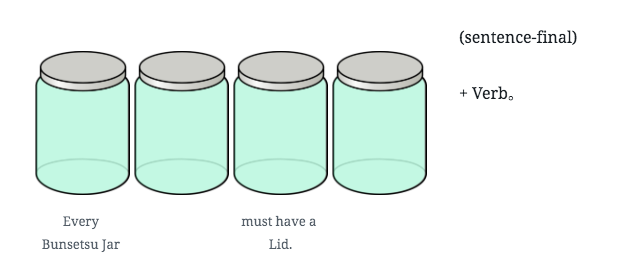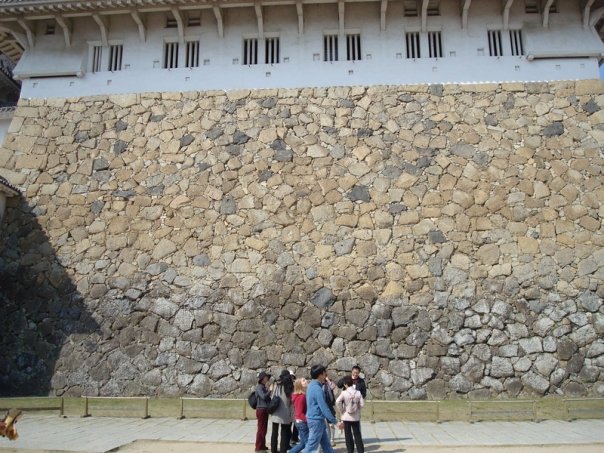Sequence is Versatile like Legos
Japanese sentence structure is quite different from English; although it’s demonstrated as TSOV instead of SVO (topic, subject, object, verb, instead of subject-verb-object like English), Japanese has a much more elegant syntax that doesn’t actually depend on sequence.
Japanese glues small markers to each word or phrase in a sentence to describe its function. These markers are called Particles and they take the shape of Query Particles and Elaborative Particles.
Q に で を が と へ
E は も
Simply Glue a word to the correct particle and tack on a sentence-final verb:
[ Ball “oh”を] bounce.
Congratulations! You’ve formed a complete Japanese sentence!
Bunsetsu Jars
Complete Bunsetsu Jar = Bunsetsu Contents + Bunsetsu Lid
Contents of the Jar are the word, the Lid of the jar is a Particle.
Every Bunsetsu Jar must have a Bunsetsu Lid (although in modern Japanese, common lids will sometimes be omitted from speech and writing)
[ BUNSETSU CONTENTS + LID ] is a complete BUNSETSU JAR.
[Ginaと] [Televisionを] watch。 (2 complete bunsetsu jars with verb at end.)


Query Particles Explain Who, What, When, Where
Q に で を が と へ
Query Particles describe “when, where to, the setting, the subject, with whom, with what, which direction” (respectively, for the Q list)
Query Particles に で を が と へ
In general, Query Particles explain Who What When Where, and can even explain matters such as “With what implement or tool was it done,” “According to,” and have many senses. In general they answer a question by providing a concrete noun (a label for a person, place, or thing).
Ga が is the Subject-Marker Particle.
Sally-San が Bicycle を Purchased.
Sally bought a bike.
〇が (zero-ga)
In Japanese there is a phenomenon called the Zero-Ga or Null-Ga and 〇が is used to teach the subtlety that the subject of a conversation need not be mentioned more than once. Subjects are marked by Ga が and typically need to be worked out from context or walking back through the conversation logs because Japanese does not use identifying 3rd-person terms “he, she, it” making Japanese more opaque than English regarding agents/actors.
Elaborative Particles は も
Elaborative Particles are quite versatile, and can replace any one of the Query Particles. In the case of Wa は, the noun marked with particle は gets elevated to Topic. Topic in Japanese is kind of like “Top of Mind” and the Topic, once set by は may go unmentioned later.
The Particle Mo も, also an Elaborative Particle, means “also” and expresses “even to this point, even to this person, or to this place” to convey extreme overflow or reach.
Mixing and Matching
Query Particles can be replaced by Elaborative Particles
John-San が Japan に go。John will go to Japan.
Jane-SanもJapanにgo。Jane also will go to Japan.
And Query Particles other than が can be combined with an Elaborative Particle to make double particle pairs:
Denverにもgo。 Go to Denver also.
Parkではeasy。Library では hard.
It’s easy (to do that) at the Park. It’s hard to do that at the Library.
Common Senses for Some Major Query Particles
に “Ni” like “knee” – Destination of Travel
Florida に travel。 Ohio に drive。
に “Ni” – Marker for the person you are Meeting (when the sentence-final verb is “to meet”)
Friend に meet。
に “Ni” to mark a specific time of action.
4pm に Denver に go。[multiple particles with different senses ✔️]
で “De” (shorter than “day”) to mark a setting or a locality of a happening.
Central Park で Ultimate Frisbee を enjoyed。
で “De” to explain with which implement, via which tool you’ll do something, or with what something was accomplished.
Airplane で Australia に traveled。
を ”oh” (written and keyed-in as “wo”) marks the Direct Object
Karen-San が Basketball を Borrowed.
Karen (marked as the subject) borrowed the basketball (marked as direct object).

Thanks for taking this brief look at Japanese Particles with us. We will be writing more about the fundamentals of Japanese Grammar and How to Think in Japanese. To learn more about our new language curriculum offerings please navigate to https://japanesecomplete.com/overview

One thought on “Basic Sentence Structure of Every Japanese Sentence”